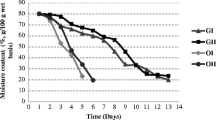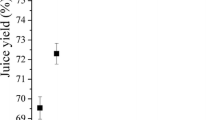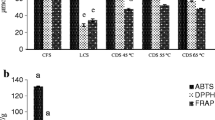Abstract
Peels are major byproducts of the juice processing industry. Citrus peels are composed of two tissues, namely the flavedo (outer layer) and the albedo (inner layer). Here, flavedo and albedo were obtained from the peel of grapefruit cv. ‘Star ruby’, lemon cv. ‘Akragas’, and sweet orange cvs. ‘Tarocco’, ‘Sanguinello’ and ‘Moro’. Freeze dried flavedo and albedo were investigated for their functional properties, and subjected to enzyme-assisted extraction with pectinase and cellulase (concentration of 6 U g−1 DW) to extract the phenolic compounds. Albedo showed superior physicochemical characteristics than flavedo. Albedo from ‘Tarocco’ exhibited the maximum water holding capacity (10.9 ± 0.48 g/g). Grapefruit albedo revealed the highest water swelling (13.4 ± 2.62 mL/g) and oil binding (6.31 ± 2.62 g/g) capacities. As regards the enzyme-assisted extraction of phytochemicals, both enzymes enhanced the extraction of phenolics (p < 0.05) compared to the controls. In flavedo, pectinase and cellulase increased the recovery of phenolics by approx. 30%, whereas in albedo the yields were increased above 60%. Results from this investigation suggest that albedo might be used by the food industry as a novel raw material, due to its superior physicochemical properties. Moreover, results provide evidence that the enzyme-assisted extraction is advantageous to recover phenolics from the citrus peels.
Graphic abstract




Similar content being viewed by others
Abbreviations
- AE:
-
Assisted extraction
- BD:
-
Bulk density
- CTRL:
-
Control
- DW:
-
Dry weight
- GLCS:
-
Glucoside
- GrAl:
-
Grapefruit albedo
- GrFl:
-
Grapefruit flavedo
- LeFl:
-
Lemon flavedo
- LeAl:
-
Lemon albedo
- MoAl:
-
Moro albedo
- MoFl:
-
Moro flavedo
- OBC:
-
Oil binding capacity
- PCA:
-
Principal component analysis
- SD:
-
Standard deviation
- SaFl:
-
Sanguinello flavedo
- SaAl:
-
Sanguinello albedo
- TaFl:
-
Tarocco flavedo
- TaAl:
-
Tarocco albedo
- WHC:
-
Water holding capacity
- WSC:
-
Water swelling capacity
References
N. Mahato, K. Sharma, M. Sinha, M.H. Cho, Citrus waste derived nutra-/pharmaceuticals for health benefits: current trends and future perspectives. J. Funct. Foods 40, 307–316 (2018)
S.N. Joglekar, P.D. Pathak, S.A. Mandavgane, B.D. Kulkarni, Process of fruit peel waste biorefinery: a case study of citrus waste biorefinery, its environmental impacts and recommendations. Environ. Sci. Pollut. Res. 26, 34713–34722 (2019)
F. Teixeira, B.A. dos Santos, G. Nunes et al., Addition of orange peel in orange jam: evaluation of sensory, physicochemical, and nutritional characteristics. Molecules 25, 1670 (2020)
FAOSTAT. (2020) In: The Food and Agriculture Organization of the United Nations. http://www.fao.org/faostat/en/#data/QC. Accessed 13 May 2020
J. Ke, G. Jiang, G. Shen et al., Optimization, characterization and rheological behavior study of pectin extracted from chayote (Sechium edule) using ultrasound assisted method. Int. J. Biol. Macromol. 147, 688–698 (2020)
S.S. Hosseini, F. Khodaiyan, M. Kazemi, Z. Najari, Optimization and characterization of pectin extracted from sour orange peel by ultrasound assisted method. Int. J. Biol. Macromol. 125, 621–629 (2019)
P. Chavan, A.K. Singh, G. Kaur, Recent progress in the utilization of industrial waste and by-products of citrus fruits: a review. J. Food Process. Eng. 41, e12895 (2018)
P. Putnik, D.B. Kovacevic, A.R. Jambrak et al., Innovative “green” and novel strategies for the extraction of bioactive added value compounds from citrus wastes-a review. Molecules 22, 680 (2017)
V. Sicari, T.M. Pellicano, A.M. Giuffre et al., Physical chemical properties and antioxidant capacities of grapefruit juice (Citrus paradisi) extracted from two different varieties. Int. Food Res. J. 25, 1978–1984 (2018)
V. Sicari, T.M. Pellicano, A.M. Giuffre et al., Bioactive compounds and antioxidant activity of citrus juices produced from varieties cultivated in Calabria. J. Food Meas. Charact. 10, 773–780 (2016)
S. Multari, C. Licciardello, M. Caruso, S. Martens, Monitoring the changes in phenolic compounds and carotenoids occurring during fruit development in the tissues of four citrus fruits. Food Res. Int. 134, 109228 (2020)
N. M’hiri, I. Ioannou, M. Ghoul, N.M. Boudhrioua, Phytochemical characteristics of citrus peel and effect of conventional and nonconventional processing on phenolic compounds: a review. Food Rev. Int. 33, 587–619 (2017)
A.R. Ruviaro, P. de Menezes Barbosa, G.A. Macedo, Enzyme-assisted biotransformation increases hesperetin content in citrus juice by-products. Food Res. Int. 124, 213–221 (2019)
J. Nishad, S. Saha, C. Kaur, Enzyme- and ultrasound-assisted extractions of polyphenols from Citrus sinensis (cv. Malta) peel: a comparative study. J. Food Process. Preserv. 43, 14046 (2019)
Y. Zhang, J. Qi, W. Zeng et al., Properties of dietary fiber from citrus obtained through alkaline hydrogen peroxide treatment and homogenization treatment. Food Chem. 311, 125873 (2020)
O.O. Olukomaiya, O.Q. Adiamo, W.C. Fernando et al., Effect of solid-state fermentation on proximate composition, anti-nutritional factor, microbiological and functional properties of lupin flour. Food Chem. 315, 126238 (2020)
S. Multari, I. Carafa, L. Barp et al., Effects of Lactobacillus spp. on the phytochemical composition of juices from two varieties of Citrus sinensis L. Osbeck: “Tarocco” and “Washington navel.” LWT Food Sci. Technol. 125, 109205 (2020)
S. Schalow, M. Baloufaud, T. Cottancin et al., Orange pulp and peel fibres: pectin-rich by-products from citrus processing for water binding and gelling in foods. Eur. Food Res. Technol. 244, 235–244 (2018)
U.R. Ramasamy, H. Gruppen, M.A. Kabel, Water-holding capacity of soluble and insoluble polysaccharides in pressed potato fibre. Ind. Crop Prod. 64, 242–250 (2015)
M.C. Lopez-Marcos, C. Bailina, M. Viuda-Martos et al., Properties of dietary fibers from agroindustrial coproducts as source for fiber-enriched foods. Food Bioprocess. Technol. 8, 2400–2408 (2015)
Y. Liu, A. Liu, S.A. Ibrahim et al., Isolation and characterization of microcrystalline cellulose from pomelo peel. Int. J. Biol. Macromol. 111, 717–721 (2018)
F. Ye, B. Tao, J. Liu et al., Effect of micronization on the physicochemical properties of insoluble dietary fiber from citrus (Citrus junos Sieb. ex Tanaka) pomace. Food Sci. Technol. Int. 22, 246–255 (2016)
M. Ben Zid, C. Dhuique-Mayer, S. Bellagha et al., Effects of blanching on flavanones and microstructure of Citrus aurantium peels. Food Bioprocess. Technol. 8, 2246–2255 (2015)
M. Ben Zid, C. Dhuique-Mayer, M. Lartaud et al., Effects of osmotic treatments on modulating bitter flavanones glycosides contents and microstructure of Citrus aurantium peels. Food Bioprocess. Technol. 8, 2461–2469 (2015)
S. Giovanelli, D. Ciccarelli, G. Giusti et al., Comparative assessment of volatiles in juices and essential oils from minor Citrus fruits (Rutaceae). Flavour Frag. J. 35, 639–652 (2020)
M. Miura, M. Nogami, M. Sakai et al., Rapid LC-MS/ MS determination of hesperidin in fermented tea prepared from unripe satsuma mandarin (Citrus unshiu) fruits and third- crop green tea (Camellia sinensis) leaves. Anal. Sci. 36, 1243–1249 (2020)
C. Guo, Y. Shan, Z. Yang et al., Chemical composition, antioxidant, antibacterial, and tyrosinase inhibition activity of extracts from Newhall navel orange (Citrus sinensis Osbeck cv. Newhall) peel. J. Sci. Food Agric. 100, 2664–2674 (2020)
N. Zarate-Vilet, C. Wisniewski, E. Gue, M. Delalonde, Towards a better identification of naringin and narirutin dispersion state in grapefruit peel press liquor. Chem. Eng. Res. Des. 159, 205–214 (2020)
C. Le Bourvellec, C.M.G.C. Renard, Interactions between polyphenols and macromolecules: quantification methods and mechanisms. Crit. Rev. Food Sci. Nutr. 52, 213–248 (2012)
N. Bordenave, B.R. Hamaker, M.G. Ferruzzi, Nature and consequences of non-covalent interactions between flavonoids and macronutrients in foods. Food Funct. 5, 18–34 (2014)
S. Multari, A. Marsol-Vall, M. Keskitalo et al., Effects of different drying temperatures on the content of phenolic compounds and carotenoids in quinoa seeds (Chenopodium quinoa) from Finland. J. Food Compos. Anal. 72, 75–82 (2018)
T. Lau, N. Harbourne, M.J. Oruna-Concha, Optimization of enzyme-assisted extraction of ferulic acid from sweet corn cob by response surface methodology. J. Sci. Food Agric. 100, 1479–1485 (2020)
Funding
Funding was provided by Symrise AG, Holzminden, Germany.
Author information
Authors and Affiliations
Corresponding author
Additional information
Publisher's Note
Springer Nature remains neutral with regard to jurisdictional claims in published maps and institutional affiliations.
Supplementary Information
Below is the link to the electronic supplementary material.
Rights and permissions
About this article
Cite this article
Multari, S., Licciardello, C., Caruso, M. et al. Flavedo and albedo of five citrus fruits from Southern Italy: physicochemical characteristics and enzyme-assisted extraction of phenolic compounds. Food Measure 15, 1754–1762 (2021). https://doi.org/10.1007/s11694-020-00787-5
Received:
Accepted:
Published:
Issue Date:
DOI: https://doi.org/10.1007/s11694-020-00787-5




